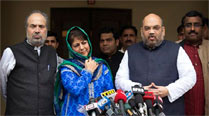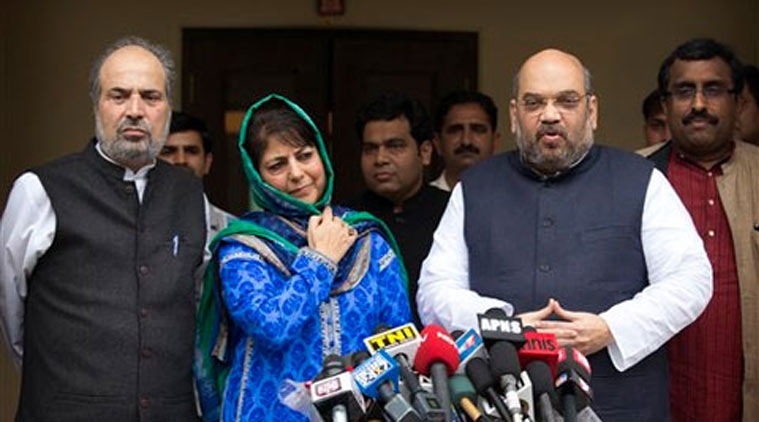Opinion Meeting point Srinagar
A PDP-BJP coalition could help heal the rift between Jammu and Kashmir.

 The BJP had reasons for pursuing an alliance with the PDP that had nothing to do with conspiracies to ‘saffronise’ the Valley.
The BJP had reasons for pursuing an alliance with the PDP that had nothing to do with conspiracies to ‘saffronise’ the Valley.
The agreement between the PDP and BJP to form a coalition government in Jammu and Kashmir has been attacked from both sides. In Kashmir, the PDP is being accused by the radicalised intelligentsia of selling out to come back to power. And on February 16, the RSS launched a scathing attack on the BJP’s negotiators for resiling from the party’s long-standing commitment to delete Article 370 of the Constitution and agreeing to phase out the Armed Forces (Special Powers) Act.
Government formation will not end the acrimony. Before the elections, both the BJP and the PDP had confidently predicted that they would win handsomely on their own. The suspicion will therefore linger that both have sacrificed their basic principles in order to save face. These suspicions do justice to neither party. Mufti Mohammad Sayeed could have easily formed a government with the Congress, the five independent MLAs and Sajjad Lone’s party, all of whom had offered him their support. But he deliberately chose the harder option of trying to forge an alliance with the BJP because he understood that this was the only way of making Narendra Modi’s BJP truly understand and address the specific concerns of the Valley.
Chief of these is the conviction of Kashmiris on both sides of the LoC, born out of six decades of bitter experience, that they will never know peace till the conflict with Pakistan over their status is resolved. Mufti also learned from his own bitter experience in 2008 that Kashmir would never get a stable government, and true peace, till the growing rift between Jammu and Kashmir was healed.
The origins of this rift go back to the days of the maharajas, when Kashmir’s emerging intelligentsia began to chafe against Dogra, that is Jammu’s, dominance of the kingdom. Kashmir gained ascendancy when the National Conference came to power in 1947, but it was Jammu’s turn to nurse a grievance. In 1949, the maharaja’s party, the Praja Parishad, merged with the Bharatiya Jana Sangh on a platform of complete union with India. This presented a threat to Kashmiri ethno-nationalism — “Kashmiriyat”.
The 2002 elections, possibly the first entirely free elections in the Valley, ousted the National Conference but the fragility of the PDP-Congress alliance showed how deep the divide had grown. For, as the 2008 elections approached, then Chief Minister Ghulam Nabi Azad was forced to attach greater importance to fending off the BJP’s challenge in Jammu than preserving the autonomy of Kashmir. The conflict finally came to a head with the Amarnath land scam of 2008, when the BJP in Jammu blockaded the Kashmir Valley and prevented most of its fruit harvest from reaching the Indian market.
The 2014 election results have shown that, far from subsiding after the 2008 crisis, the divide between Jammu and Kashmir has become almost unbridgeable. After his own searing experience in 2008, Mufti was convinced that healing the rift had to be his first task. He had appreciated the promptness with which the court martial and sentencing of the five soldiers involved in the killing of three boys in the Machil fake encounter of 2010 had occurred under the Narendra Modi government. He therefore chose the harder path of forming a government with the BJP.
The BJP had reasons for pursuing an alliance with the PDP that had nothing to do with conspiracies to “saffronise” the Valley. It had gained an absolute majority in Parliament last May, with a vote share of just 31 per cent, only because of the collapse of the Congress and the resulting absence of an organised opposition. It knew that this would not last forever. Its leaders, therefore, faced the same choice that Atal Bihari Vajpayee and L.K. Advani had after 1991: to retain power, the BJP had to broaden its support base, but to do so, it had to dilute its ideology and move further towards pragmatism. Modi had been begun moving away from the Sangh Parivar’s hardliners shortly before President Obama’s visit. This shift has gained momentum after the visit: in recent weeks, it is not only Modi, but also RSS chief Mohan Bhagwat who has made a point of quoting Swami Vivekananda’s immortal 1894 speech on Hinduism in public addresses.
The two parties have taken so long to arrive at an agreement because the gap between them was very large. Jammu wants an end to the ambivalence of its position within the Indian Union. It wants refugees who fled from Pakistan in 1947 to be granted full citizenship and voting rights in the state, and a redrawing of constituencies to accommodate them. It also wants a series of state laws on citizenship and inheritance to be brought in line with Indian law.
But it can only have these if it respects, and concedes, the Valley’s need to preserve its distinct identity, its Kashmiriyat. Thus, the demands of the PDP add up to just this: let sleeping dogs like Article 370 lie, and do not disturb the process of normalisation with Pakistan that began in 2005.
With sagacious leadership, a BJP-PDP coalition in Jammu and Kashmir could create a win-win situation not only for Kashmir, not only for India, but also for the whole of South Asia. It would prove to Kashmiris that they have nothing to fear from a Hindu-dominated Central government in India. By reassuring the world that India remains wedded to religious pluralism and syncretism, it would enable Modi to wield India’s “soft power” more effectively in the shaping of a new international order. It would enable India to resume the normalisation process in Kashmir and substantially improve Pakistan’s chances of winning the do-or-die battle against sectarian terrorism initiated by its 20-point National Action Plan and its 21st constitutional amendment. The resulting build-up of trust could also facilitate cooperation to stabilise Afghanistan after the US leaves.
Finally, working with the PDP could wear down the hard edge of prejudice against Muslims that lies at the core of the Sangh Parivar’s ideology. Six years of peaceful, responsible coalition rule in J&K, India’s only Muslim-majority state, will therefore go a long way towards healing the wounds that Partition inflicted on the Hindu psyche 67 years ago.
Jha is a senior journalist and author.
express@expressindia.com





